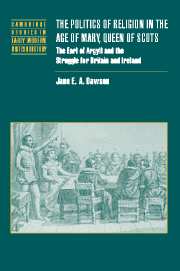 The Politics of Religion in the Age of Mary, Queen of Scots
The Politics of Religion in the Age of Mary, Queen of Scots Book contents
- Frontmatter
- Contents
- List of figures
- Acknowledgements
- List of abbreviations
- Prologue: 1560: British policies and the British context
- 1 Argyll's life and character
- 2 Semi-sovereign prince
- 3 The creation of a British policy: 1558–1560
- 4 The collapse of amity: 1561–1565
- 5 The reconfiguration of British politics: 1566–1568
- 6 The withdrawal from British politics: 1569–1573
- Conclusion: The earl of Argyll and British politics in the age of the three kingdoms
- Chronology, 1558–1573
- Bibliography
- Index
6 - The withdrawal from British politics: 1569–1573
Published online by Cambridge University Press: 20 July 2009
- Frontmatter
- Contents
- List of figures
- Acknowledgements
- List of abbreviations
- Prologue: 1560: British policies and the British context
- 1 Argyll's life and character
- 2 Semi-sovereign prince
- 3 The creation of a British policy: 1558–1560
- 4 The collapse of amity: 1561–1565
- 5 The reconfiguration of British politics: 1566–1568
- 6 The withdrawal from British politics: 1569–1573
- Conclusion: The earl of Argyll and British politics in the age of the three kingdoms
- Chronology, 1558–1573
- Bibliography
- Index
Summary
After Langside, Scotland slipped further into civil war, its national politics initially splitting into two opposing parties, respectively supporting the king and queen, and then slowly disintegrating into factions with little common focus. As the most powerful magnate in the Queen's Party, Argyll played an important role in these struggles, where regional, Scottish and British strands became tangled together. With the King's and Queen's Parties locked in an uneasy stalemate and political life fragmenting, especially after Moray's assassination in January 1570, he became increasingly pessimistic about the possibility of success. In 1571, with no prospect of Mary's release from her English prison and believing peace to be essential to counter English manipulation, the 5th earl abandoned the Queen's Party. Having made his settlement with the regent, he devoted his energies to reconstructing national political life by reconciling the different factions.
The arrival of the fugitive Scottish queen in England decisively shifted the balance of power within the British mainland, further weighted in favour of the southern kingdom. The revolution that had placed the infant James on the Scottish throne left the new regime heavily dependent upon English good will. With the Scottish queen in her custody, Elizabeth's influence north of the border was further strengthened, giving her the trump cards in Anglo-Scottish negotiations and a decisive voice in Scotland's domestic politics. By sending money and troops, England's intervention eventually broke the stalemate between the King's and Queen's Parties.
- Type
- Chapter
- Information
- The Politics of Religion in the Age of Mary, Queen of ScotsThe Earl of Argyll and the Struggle for Britain and Ireland, pp. 170 - 208Publisher: Cambridge University PressPrint publication year: 2002


